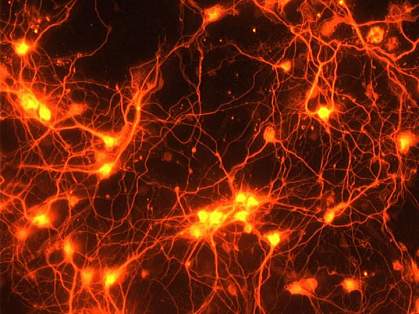You are here
November 9, 2015
Molecule proves key to brain repair after stroke
At a Glance
- Scientists found that a molecule known as growth and differentiation factor 10 (GDF10) plays a key role in repair mechanisms following stroke.
- Insights from the study will inform future research into therapies to promote stroke recovery.

Stroke occurs when blood flow to the brain is disrupted. Without oxygen- and nutrient-rich blood, brain cells start to die. Recovery after stroke depends on a process called axonal sprouting, in which healthy neurons send out new projections, or extensions. These “sprouts” generate new connections between brain cells or reestablish some of the connections that were lost or damaged during stroke, resulting in partial recovery.
Previous studies suggested that a protein called growth and differentiation factor 10 (GDF10) was involved in the early stages of axonal sprouting. Dr. S. Thomas Carmichael and his colleagues at the University of California, Los Angeles, took a closer look at GDF10 to identify how it contributes to the process. Their work was supported in part by NIH’s National Institute of Neurological Disorders and Stroke (NINDS). The findings were published online on October 26, 2015, in Nature Neuroscience.
By examining animal models of stroke as well as brain tissue from human autopsies, the team found that GDF10 was activated very early after stroke. Using rodent neurons and human neurons derived from stem cells, the researchers showed that GDF10 stimulated axonal growth and increased the length of the axons.
To see whether GDF10 is important for functional recovery after stroke, the researchers treated mouse models of stroke with GDF10 in a biopolymer hydrogel, which releases the protein to the site of injury over a 2- to 3-week period. Treated animals performed various motor tasks significantly faster and with fewer errors after stroke than control animals. In contrast, when the researchers blocked GDF10 production, the animals didn’t perform as well on the motor tasks, suggesting that repair mechanisms were impaired without GDF10.
To understand the pathways by which GDF10 might be working, the researchers isolated cortical neurons after stroke and examined their gene expression profiles. To see if the mechanisms of repair are similar to axonal sprouting during normal development when mice are forming new connections, they also examined cortical neurons from young mice. The analysis revealed that GDF10 affected a set of genes after stroke that was distinct from those involved in development.
“We found that regeneration is a unique program in the brain that occurs after injury. It is not simply Development 2.0, using the same mechanisms that take place when the nervous system is forming,” Carmichael says.
“These findings help to elucidate the mechanisms of repair following stroke,” says Dr. Francesca Bosetti, stroke program director at NINDS. “Identifying this key protein further advances our knowledge of how the brain heals itself from the devastating effects of stroke, and may help to develop new therapeutic strategies to promote recovery.”
Related Links
- Repairing Nerve Pathways With 3-D Printing
- Can You Recognize a Heart Attack or Stroke?
- Stroke Information Page
- NIHSeniorHealth: Stroke
- Brain Basics
References: GDF10 is a signal for axonal sprouting and functional recovery after stroke. Li S, Nie EH, Yin Y, Benowitz LI, Tung S, Vinters HV, Bahjat FR, Stenzel-Poore MP, Kawaguchi R, Coppola G, Carmichael ST. Nat Neurosci. 2015 Oct 26. doi: 10.1038/nn.4146. [Epub ahead of print]. PMID: 26502261.
Funding: NIH’s National Institute of Neurological Disorders and Stroke (NINDS); American Heart Association; Richard Merkin Foundation for Neural Repair; Dr. Miriam and Sheldon G. Adelson Medical Research Foundation; and the Edwin W. and Catherine Davis Foundation.
